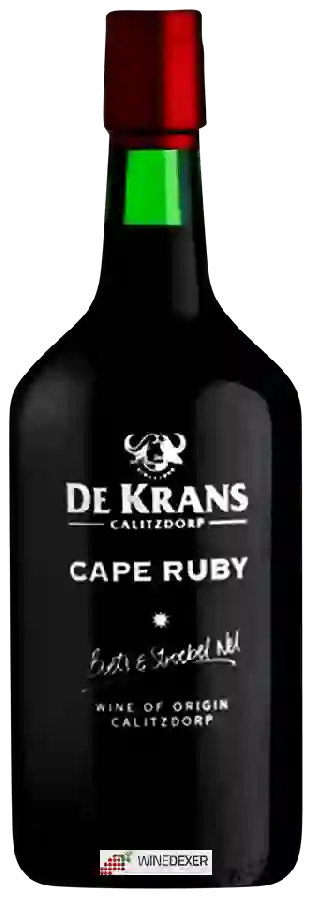
Winery De KransCape Ruby Port
This wine is a blend of 3 varietals which are the Ruby-cabernet, the Tinta Barroca and the Touriga nacional.
This wine generally goes well with beef and mature and hard cheese.
The Cape Ruby Port of the Winery De Krans is in the top 30 of wines of Calitzdorp.
Wine flavors and olphactive analysis
On the nose the Cape Ruby Port of Winery De Krans in the region of Western Cape often reveals types of flavors of oak, red fruit.
Food and wine pairings with Cape Ruby Port
Pairings that work perfectly with Cape Ruby Port
Original food and wine pairings with Cape Ruby Port
The Cape Ruby Port of Winery De Krans matches generally quite well with dishes of beef or mature and hard cheese such as recipes of beef tagine with prunes and almonds or gratin with chard leaves.
Details and technical informations about Winery De Krans's Cape Ruby Port.
Discover the grape variety: Ruby-cabernet
Intraspecific crossing carried out in 1936 by Doctor Harold Paul Olmo of the University of California in Davis (United States) between the carignan and the cabernet-sauvignon. The first plantings were made in 1948 in the United States (California). Today, it is less and less multiplied, but it can still be found in South Africa, Australia, Argentina, Chile, Uruguay, Yugoslavia, the United States, etc. In France, it is almost unknown.
Last vintages of this wine
The best vintages of Cape Ruby Port from Winery De Krans are 0
Informations about the Winery De Krans
The Winery De Krans is one of of the world's great estates. It offers 47 wines for sale in the of Calitzdorp to come and discover on site or to buy online.
The wine region of Calitzdorp
The wine region of Calitzdorp is located in the region of Klein Karoo of Western Cape of South Africa. Wineries and vineyards like the Domaine De Krans or the Domaine De Krans produce mainly wines red, natural sweet and white. The most planted grape varieties in the region of Calitzdorp are Touriga nacional, Tinta Barroca and Chenin blanc, they are then used in wines in blends or as a single variety. On the nose of Calitzdorp often reveals types of flavors of non oak, earth or microbio and sometimes also flavors of oak, tree fruit or spices.
The wine region of Western Cape
The Western Cape is home to the vast majority of the South African wine industry, and the country's two most famous wine regions, Stellenbosch and Paarl. The city of Cape Town serves as the epicenter of the Cape Winelands, a mountainous, biologically diverse area in the south-western corner of the African continent. A wide variety of wines are produced here. Wines from the Shiraz and Pinotage">Pinotage grape varieties can be fresh and juicy or Full-bodied and gutsy.
The word of the wine: Biodynamic (agriculture)
Organic agriculture is part of a vision of the world linking the plant and all living beings to the cosmos and basing work in the vineyard and the cellar on the cycles of the moon.














